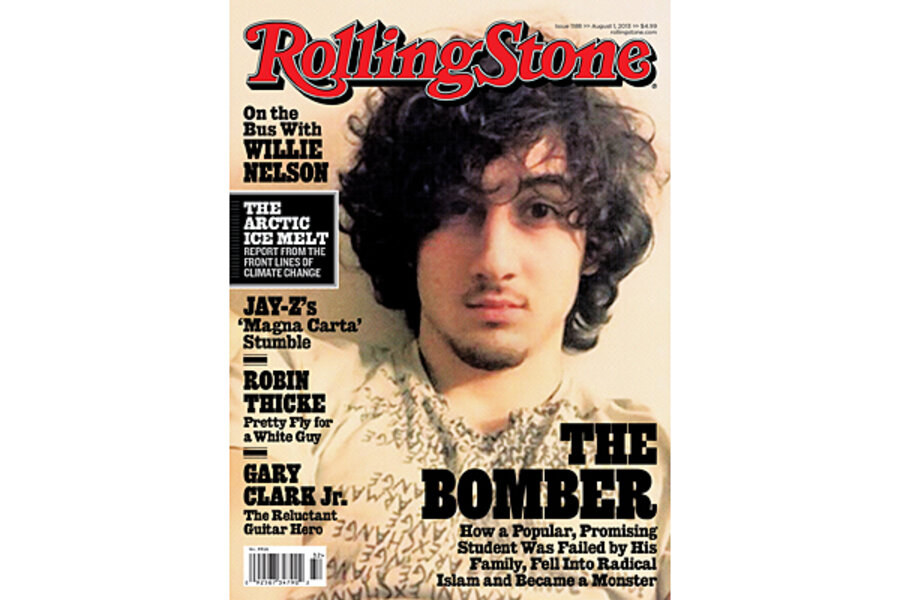Why Rolling Stone boycott backfired, as Tsarnaev cover flies off shelves
| Los Angeles
In today's media wars, there are winners and losers. And then there's Rolling Stone magazine.
Though widely denounced for featuring a glam shot of Boston bombing suspect Dzhokhar Tsarnaev on its Aug. 1 cover, Rolling Stone nonetheless comes out a winner – with sales of that particular issue soaring and the magazine's profile raised in the crowded media marketplace.
Numbers released Wednesday by Magazine Information Network show that newsstand sales of the August issue were more than double the monthly average of the past year, according to news reports. The jump came in spite of refusals by retailers such as CVS and Walgreen's to put that particular issue on their shelves, saying the cover photo glamorizes a suspected terrorist.
Only 5 percent of Rolling Stone's circulation comes from single-copy sales, but the surge in newsstand sales for the August issue, to north of 13,000, is a lesson on how media works in today’s communication-saturated environment. The lesson, in short, is that publicity of almost any kind pays.
“Media boycotts most often play into the hands of those who are being targeted,” says Ben Bogardus, chairman of the journalism department at Quinnipiac University in Connecticut. If the August issue had simply appeared without comment, it would not have garnered such numbers, he adds.
Beyond that, the controversy revives the magazine's credibility, especially in the eyes of its targeted demographic: young people, says Mr. Bogardus.
“You have a group that sees itself as anti-establishment anyway, and now here is an issue that the Establishment is boycotting. This says to that desired demographic, ‘This is really something you should read,' ” he says, noting that "you could not pay for" this kind of message-specific advertising.
In an effort to gain traction in a noisy media environment, media outlets try to reflect the social consciousness, says communications professor Joe Valenzano at the University of Dayton. After a certain publication or media outlet is in the spotlight, “people are curious.” The public is attracted to controversy, he says, and most people don't pause to consider the underlying conflicts.
“There are probably people who will buy the issue for no other reason than it serves as a marker for this moment in history,” says Mr. Valenzano, noting that many people collect magazine covers for their historic or collectible value. “Think of how many people have held onto the magazine covers from 9/11 because they serve as a reminder of that moment in our collective history.”
While magazine sales may be up for Rolling Stone, its August issue hit a sour note with advertisers. Several companies with ads in the controversial issue, including Kraft and Proctor & Gamble, were unhappy that they had received no advance warning about the cover photo, notes a recent issue of Adweek. The firms are questioning whether to place future ads with Rolling Stone, company representatives told Adweek on condition of anonymity.
But the music-and-celebrity-driven publication can afford to let advertisers be momentarily unhappy, says Paul Levinson, author of “New New Media.” “I would tell them, ‘Go ahead and advertise in a magazine that has no impact and makes no contribution to a deeper understanding of the news,' ” he says.
Rolling Stone, he suggests, provided an important service by examining the story behind a young man who, to all outward appearances, “is as normal as the guy in class next to you.” Further, says Mr. Levinson, the boycotters, not the magazine, are the ones who shirked an important public responsibility.
“It’s one thing for me to boycott a store and not enter the premises: I don’t impact anyone,” he says. But Levinson holds that a public store has a certain responsibility to make ideas available in the marketplace. “They interfered with the people’s ability to have a free flow of information, which is a cornerstone of our democracy,” he adds.
Even if advertisers shun the magazine and the boycott continues, Rolling Stone has won in an invaluable way, says Robert Thompson, an expert in pop culture, at Syracuse University in New York.
“This controversy has put Rolling Stone back on the map in a way that it has not been noticed for a long time,” says Mr. Thompson. “When [the story] first broke, I had a 25-year-old student ask me if Rolling Stone was still being published,” he says. “I guarantee that he is not asking that question any more.”





